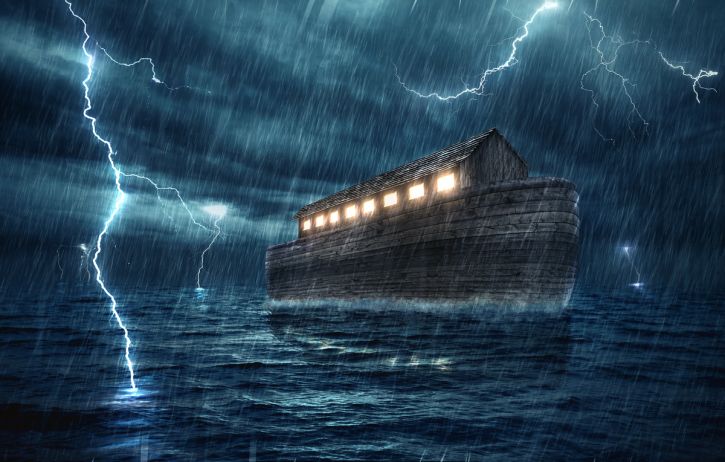Questions and Answers About the Genesis Flood
The Genesis Flood is one of the most fascinating accounts in the Bible and also one of the most challenged. This blog post looks at some common questions that are asked about the Bible’s account of a global flood.

Let’s look at some of the common questions asked about the Genesis Flood.
Question 1: Was the Flood really a global flood?
The Bible uses very descriptive terminology to describe the magnitude of the Flood. “The waters prevailed and greatly increased on the earth, and the ark moved about on the surface of the waters. And the waters prevailed exceedingly on the earth, and all the high hills under the whole heaven were covered” (Genesis 7:18-19, emphasis added throughout).
Notice the phrase “all the high hills under the whole heaven were covered.” This literally means that the highest peaks around the earth were completely submerged. Remember that water seeks its own level. The only way for the highest mountains to be completely submerged would be a global flood.
In verse 20, we read this added detail: “The waters prevailed fifteen cubits upward, and the mountains were covered.” Though we don’t know how tall the mountains stood in Noah’s time, the Bible is clear that they were completely covered by water.
Question 2: Is there evidence of the Flood outside of the Bible?
According to the book of Genesis, humanity was reestablished from a single place (the mountains of Ararat in modern Turkey). Genesis 10 describes the repopulation of the earth from that area by the offspring of Noah’s three sons: Shem, Ham and Japheth.
Since the post-Flood civilizations sprang from this common source, then you would expect that stories of the Flood would spread with them. The farther they got in time and distance from Noah, the more we would expect the details to morph and change. This is exactly what happened! Stories about a flood that destroyed mankind are found in many civilizations, from the Sumerians to Native Americans.
Since the post-Flood civilizations sprang from this common source, then you would expect that stories of the Flood would spread with them.
Many doubt the accuracy of this story because of geologic dating methods. This topic is complicated and beyond the scope of this blog post, but I recommend you read my article “Geologic Dating Methods: Are They Always Accurate?” In short, modern scientific dating methods have often been shown to be incorrect.
Consider this: A high percentage of the rocks near the earth’s surface are sedimentary, which means they were formed through the solidification of sediment, usually deposited by water. This is exactly what we would expect if the earth was covered by water for a period of time. During and after the Flood, there would have been a massive movement of water, causing erosion and sedimentary rocks. In fact, many sedimentary rocks include fossils in them, which we would expect from a rapid burial in sediment due to a sudden flood.
Question 3: How did Noah get all those animals on the ark?
Skeptics have claimed it would have been impossible to fit all species of animals found on earth today inside the ark. But there are some things to consider.
Remember that Genesis says God created different “kinds” of animals (Genesis 1:11-12). Many of those “kinds” of animals have become varied as they reproduced and adapted to the different climates of the earth. But not all of today’s thousands of different species would have had to have been placed on the ark.
For example, there are many species of cats today, but it seems only one pair of cats would have had to have been saved on the ark. The variety of cats we have today would have descended from this one pair. To learn more about the animals taken on the ark, read “Clean and Unclean Animals on the Ark.”
Feeding this large group of animals would have been a challenge, but not impossible. Today there are many examples of animals that hibernate in the winter. Remember, the Flood was a supernatural event brought about by God Himself because of mankind’s evil. God could have caused many of the animals to simply hibernate through the Flood, which would mean they wouldn’t have needed to be fed every day. Many dangerous animals (such as snakes and bears) hibernate, which would also have kept those on the ark safer.
But regardless of the exact number or whether or not some went into hibernation, note this important point: The ark that Noah built was huge!
Feeding this large group of animals would have been a challenge, but not impossible.
In Genesis 6:15 God gave specific instructions for the dimensions of the ark (in cubits). Most scholars believe the ancient cubit was roughly equivalent to 18 inches. That would make the general dimensions of the ark 450 feet in length, 75 feet in width and 45 feet in height. It also had three decks. There was a lot of space for the animals, and God could have also brought younger animals to the ark, thus taking up less space.
God was very strategic in His instructions to build this huge barge, so it’s probable that the selection of the animals to fit within the ark was just as strategic!
Question 4: How did Noah gather all the animals of the world?
Animals would have been scattered all over the world. Did Noah have to search them out and bring them to the ark? There are many examples today of birds and other animals that migrate from one place to another. One of those creatures is the Monarch butterfly, which lives in the United States and Canada in the summer and migrates to Mexico for the winter. If God could cause a worldwide Flood, He could also cause the animals from other regions to migrate toward Noah’s location.
Genesis 6:20 implies that God brought them to Noah: “Of the birds after their kind, of animals after their kind, and of every creeping thing of the earth after its kind, two of every kind will come to you to keep them alive.”
Question 5: Where did all the water come from?
Skeptics have asked how water could cover all the high mountains on the earth. Does that much water even exist in the oceans, rivers, lakes and atmosphere? Many seem to assume that the water only came from the rain, but the Genesis account shows us there was another source: “In the six hundredth year of Noah’s life, in the second month, the seventeenth day of the month, on that day all the fountains of the great deep were broken up, and the windows of heaven were opened” (Genesis 7:11).
There is much more to learn about the Flood. It is one of the most fascinating accounts in the entire Bible. Critics will continue to question whether it was myth or fact, but those who trust and believe God’s Word can have confidence that what Genesis describes about the Flood could and did happen.
Date Posted: February 6, 2019

 by Bill Jahns
by Bill Jahns

